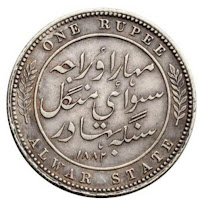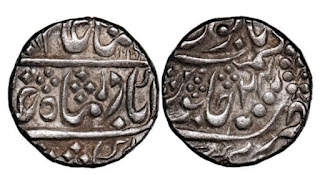Alwar is situated on the eastern edge of the Alwar Hills (a portion of the Aravalli Range, roughly equidistant from Delhi (northeast) and Jaipur (southwest). In the middle ages, the region was under Muslim rule, and was the capital of Mewat, a province of the Mughal Empire. In the later half of the 18th century, following the death of Emperor Aurangzeb in 1707 AD, Pratap Singh created the State of Alwar in 1775 AD.
Pratap Singh had been a General in the Jaipur (Amer) army, but had revolted against it to form a kingdom of his own. The new kingdom also included some areas of Bharatpur and Jaipur's territory. Pratap Singh died in 1791 and till then the British were nowhere close to this area.
Flag
Coat of Arms
Maharaja Pratap Singh did receive recognition from Shah Alam, the Mughal Emperor in Delhi. Alwar was recognised as a state in 1803 by the British. Whilst the British were fighting the Scindia of Gwalior in Laswari, Alwar's second ruler Bakhtawar Singh, rushed on his own to help the British against the Scindia. Under a treaty signed with the British, Bakhtawar Singh was recognized as a legitimate ruler of Ulwar, renamed as Alwar a hundred years later.
During its 173 years history, Alwar had seven Maharajas, they were called Maharao Rajas till 1889, when the title was raised to that of a Maharaja.
Maharaja Bane Singh (1815-1857) was the third Maharaja and he actually established Alwar as a state. He built the imposing City Palace and the Sagar tank at the foothill that has the 700 years old Alwar Fort. He remained loyal to the British and sent them troops to fight the ''First Rebellion'' in 1857.
Sawai Mangal Singh (1874-1892) was educated in the Mayo College, Ajmer. He was an Honorary Lieutenant Colonel in the British Army in 1885 and was enrolled as a ''Knight Grand Commander of the Most Exalted Order of the Star of India''. He died when he was 34 years old.
Sawai Sir Jai Singh (1892-1937) was also educated at the Mayo College and was conferred the title of K.C.S.I (Knight Commander) in 1909. Alwar supported the war effort of the British Government during the World War I. At the end of the war, the title of G.C.I.E and G.C.S.I (Knight Grand Commander) in 1919 and 1924 respectively.
Col Maharaja Sir Jai Singh
The Rolls Royce story. Not many of us know that before first world war more than 20,000 Rolls Royce were manufactured and almost 20 percent were shipped to India. At that time there were about 230 Indian Kings and there were more than 2000 Rolls Royce in India. In 1920, Maharaja Jai Singh was walking around the streets of Mayfair area of London and he walked into a showroom of Rolls Royce. The British salesman ignored him and thought he was an ordinary poor Indian. As Jai Singh could not take the humiliation, he returned to his hotel and asked his servants to call the showroom and tell them that the King of Alwar is keen to buy some cars. He visited the showroom in his royal appearance, purchased all the six cars there, paid full amount including delivery charges. Once the cars reached India, he ordered the Municipality to use these cars to sweep the streets and to use them also to collect and transport garbage. As this news spread across the world, the number one car manufacturer was in total shock. Their revenue and reputation dropped rapidly. They apologized and offered six more new cars free of cost, after which the practice was stopped
Jai Singh was a brilliant writer and orator and one of the best polo players. He changed the name from Ulwar to Alwar. He built the Itarana Palace that was modelled on an Italian villa but never occupied due to superstition. Siraska Palace was very casually occupied too. His nearly 30 years rule was spent in extravagances and the treasury was emptied completely. In debt, he imposed heavy taxes that resulted in agrarian uprisings. Due to his inability to control, he sought help of the British. He handed over the administration to the British who forced him into exile in 1933. He died in Paris in 1937.
Thereafter in the 11 years of British Rule, there were demographic changes in Alwar as a sudden influx of Punjabis changed the socio-cultural life of the place.
Maharaja Tej Singh, (1911-2009) a distant cousin of Jai Singh was made the Maharaja in 1937. He did not have any formal education. He was however not allowed to interfere with the administration, which was with the British. Ruling power was given in 1944. Following the partition of India in 1947 and Alwar's accession in March 1948 the state merged with three neighbouring princely states Bharatpur, Dholpur and Karauli to form the Matsya Union. In May 1949, it was made a part of the state of Rajasthan.
Coins of Alwar
One Takka, Shah Alam, 1774-1799 AD, copper, weight 19 gm
Rupee, Mangal Singh, 1891 AD, Calcutta mint, weight 11.5 gm, silver, Portrait of Victoria Empress, KM 45

























No comments:
Post a Comment
Any inputs or feedback is welcome!